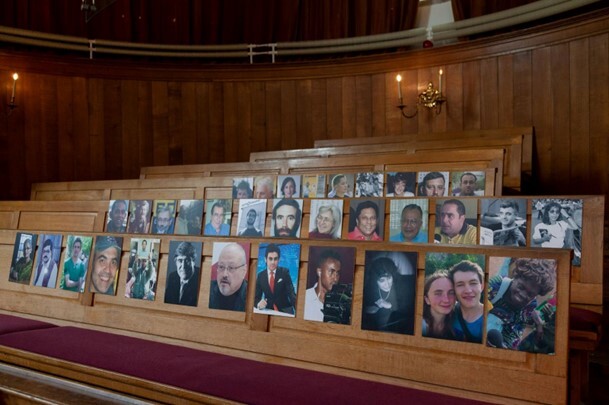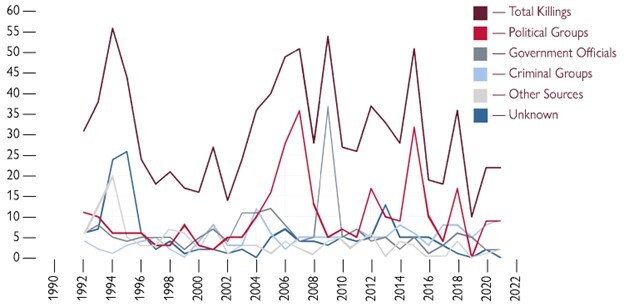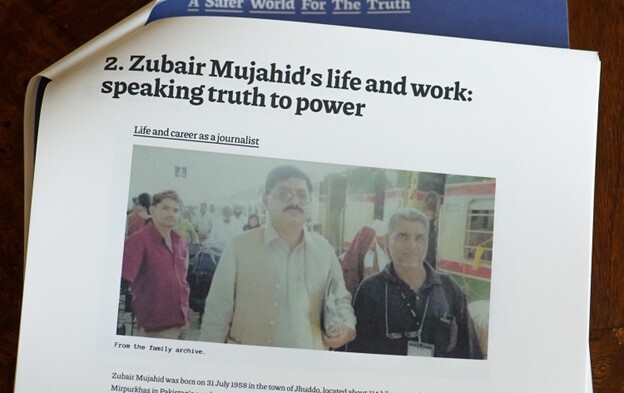 Exhibit at The People's Tribunal on the Murder of Journalists. Nieuwe Kerk, The Hague; September 19, 2022
Do you recognize one of the slain journalists in these photographs? According to UNESCO, every four days a journalist is killed in the world. In nine of 10 cases, the killers go unpunished. While conflict zones have presented the greatest threat to journalists over the past decade, the Committee to Protect Journalists (CPJ) reports that out of 2,204 journalists and media workers killed between 1992 and 2023, 946 of them—nearly half—were murdered while working in a non-conflict zone. In fact, UNESCO’s 2022 Report on the Safety of Journalists and the Danger of Impunity found that journalists have become less safe in countries not experiencing armed conflict than they are in conflict countries.
Violence against journalists has a chilling effect that can lead to journalistic self-censorship, with profound implications for citizens’ access to high-quality information. As the Council of Europe declares “at the center of the supreme value of democracy and human rights is the right of everyone to receive and impart information.” Threats to journalists directly undermine the public's fundamental right to information and to engage in public debate. Research demonstrates that threats against journalists are a significant predictor of self-censorship and future human rights abuses, reduce the volume of journalism, and affect the tone of the journalism. Over time, violence also reduces the number of journalists and news outlets.
This edition of the DRG Learning Digest examines the following topics:
- Where are Journalists Most at Risk? Hybrid Regimes
- Engaging the Traditional Justice Sector to Protect Journalists
- When the Justice System Falters: Pioneering Grassroots Approaches
Please make use of DRG Evidence and Learning Team resources! (See text box at the end.)
Where Are Journalists Most at Risk? Hybrid Regimes
Does partial democracy make journalists safer than in autocratic regimes? A 2016 study analyzing cross-national data on journalist killings between 1992 and 2008 argued that more democratic contexts make it easier for journalists to pursue stories that put them at risk, while autocratic regimes provide fewer opportunities to follow dangerous leads. Building on this evidence, “An Uphill Battle: From Impunity to Justice for Journalist Murders (Impunity Report),” a 2022 report by the Netherlands-based Free Press Unlimited (FPU), concluded that “hybrid regimes” (those combining both democratic and undemocratic elements) were the highest-risk environment for journalists, with the highest loss of journalists’ lives and high rates of impunity. Between 2000 and 2018, 67 percent of journalist murders took place in hybrid regimes.
An analysis of 1,812 killings of journalists found that most died in countries where formal democratic norms and practices at the national level encourage investigative reporting in local arenas, where those in power have incentives to violently suppress critical press coverage. Unsurprisingly, these actors often benefit from malfunctioning rule of law, corruption, and abuse of power, all of which are common in hybrid regimes. A study of Mexico’s 32 states suggests that violent deaths of journalists are more likely to happen in subnational entities with high levels of social violence and internal conflict, severe violations of human rights, low democratic development and high levels of economic inequality. Further analysis suggests that in contexts where local governments are elected but have limited options to restrict press, negative reporting could mean that local politicians lose power and influence, especially those involved in corrupt practices. This points to the risks inherent to covering local elections, particularly for less visible journalists, which are multiplied along with the power of journalism to disrupt bad actors in local politics. The recently published Anti-Press Violence in Subnational Undemocratic Regimes suggests that critical reporting increases the risk of central interventions into subnational politics, which can be an even greater risk to local politicians than losing elections. Local elections can be unfair and based on clientelism, while critical reports about corruption can lead to investigations and other forms of intervention.
Relying on data from the Committee to Protect Journalists, FPU’s Impunity Report highlights three main groups of perpetrators who are responsible for 90 percent of journalist murders. In 42 percent of murders, the perpetrators are involved with anti-government parties or combatants, including insurgents and terrorists. In 30 percent of the cases, the perpetrators are government officials, including police and military personnel. An additional 18 percent are perpetrated by criminals or members of criminal gangs, including drug traffickers.
 The proportion of journalist murders by different groups of perpetrators. Source: FPU’s Impunity Report.
Engaging the Traditional Justice Sector to Protect Journalists
While there is little evidence that high murder rates fuel a “cycle of impunity,” the FPU’s research shows that impunity and the risk of murder have the same causes: dysfunctional rule of law with strong discrepancies between the national and subnational levels. The same dynamics that allow culprits to murder journalists also allow them to sabotage official investigations and foster impunity through positions of power. Engaging judicial and prosecutorial actors is therefore critical to reducing violence against journalists.
Surprisingly, divergent standards of rule of law in hybrid regimes also can offer concrete opportunities for ending impunity. This is demonstrated through quantitative data and case studies. Data from Brazil, Mexico, and the Philippines demonstrate that triggering certain segments of the formal legal system in hybrid regimes can increase the likelihood of justice. The FPU found that the engagement of central judicial or prosecutorial actors in a murder case can increase the likelihood of justice, even if partial, from 38 to 62 percent.
According to the FPU’s Impunity Report, Mexico was the country with the highest number of journalist murders of the last decade and an extreme example where subnational actors have targeted journalists. In 2022, 13 journalists were killed in Mexico due to their work and dozens of others were attacked or threatened. USAID’s Por la Protección de Defensores y Periodistas (PDP) activity, launched in August 2021, partners with federal institutions such as the Special Prosecutor for Crimes Against the Freedom of Expression (FEADLE) and the National Protection Mechanism for Journalists to increase prosecution rates for crimes against freedom of expression, enhance risk analysis, and increase protection measures. PDP also collaborates with five state-level counterparts to improve the prevention and protection system for journalists and human rights defenders.
In addition to supporting these professions, USAID/Mexico also promoted the creation of the Coordination Group of Specialized Prosecutors on Freedom of Expression and Human Rights Defense in the most affected states. The objective is to share experiences and good investigatory practices, enhance collaboration between local and federal institutions, and improve national data reporting in order to bring attention to the murders of journalists. This is an important milestone for the investigation of crimes, considering that this is the first time that Mexico’s state-level Attorney General Offices will have this kind of register.
Local journalists from several Mexican states pose in front of the Revolution Monument while attending the USAID-supported Independent Journalism Workshop in 2019. Photo: Mauricio Zapata, ProVoces
When the Justice Sector Falters: Pioneering Grassroots Approaches
Traditional justice is not always enough to counteract and prevent violence against journalists. In fact, according to the Impunity Report, research shows that reducing impunity does not, by itself, lead to a decrease in murders of journalists. In countries that lack effective approaches to justice or the capacity and willpower to protect journalism, the international human rights law concept of transitional justice could bolster collective will and combat impunity. Transitional justice concepts include truth-telling, criminal investigations and prosecutions, reparations, and institutional reforms to guarantee non-recurrence.
One example of the use of innovative transitional justice approaches is the Safer World for the Truth initiative, implemented by FPU in collaboration with the CPJ and Reporters Without Borders (RSF), which investigates, documents, and pursues justice for murdered journalists. Case studies indicate that investigating cold cases of journalist murders and publicizing the findings through reports, articles, and People’s Tribunals, even if not legally binding, can lead to tangible outcomes in the protection of journalists overall. For example, the findings exposed at People’s Tribunals in the cases of Miguel Ángel López Velasco and Lasantha Wickrematunge were requested by and submitted to the FEADLE in Mexico and the United Nations Office of the High Commissioner for Human Rights’ investigation on Sri Lanka, respectively.
Further, thorough analysis of individual cases exposes systemic vulnerabilities in the prosecution of journalists’ murders. The investigation of the murder of Brazilian journalist Pedro Palma revealed procedural issues pertaining to the handling of cold cases and the administration of evidence. The corresponding recommendations were well received by the responsible Brazilian authorities at the presentation of the report in Rio de Janeiro. In Pakistan, a national taskforce for the investigation of journalist murders led by Pakistani journalists and lawyers, was a direct result of the investigation into the murder of Zubair Mujahid, which concluded that the official investigation was erroneous and ineffective from the beginning. The Safer World for the Truth investigation revealed that the official police investigation was actively sabotaged by the very department that had threatened to silence Mujahid prior to the murder. As a result of this investigation, Mujahid’s family filed a petition at the High Court of Sindh to reopen the investigation and Safer World for the Truth investigation was used as an annex to the petition.
 Image of Zubair Mujahid from “Breaking the Silence: An Investigation into the Murder of Zubair Mujahid,” an investigation by A Safer World for the Truth.
Findings from investigations have also stimulated policy implications beyond national borders, such as the adoption of a motion in the Dutch parliament regarding the establishment of an international investigative task force for journalist murders following government recommendations that cited domestic and international press freedom reports. The investigation of the murder of journalist Elisabeth Blanche Olofio from the Central African Republic has stimulated recognition in international advocacy efforts of the potential for emergency visas to save lives.
Finally, by zooming in on individual cases, A Safer World for Truth was able to map patterns of threats and formulate hypotheses around the chain of events leading up to journalist murders. Additionally, by combining these patterns and hypotheses with data from support requests by journalists following threats and/or attacks (available through FPU’s Reporters Respond program) and with investigation findings, A Safer World for Truth built a prevention model to detect early warning signals and better anticipate the occurrence of lethal danger. According to the project’s team, this is one of the most promising avenues for further work across academia and civil society, particularly on the local level. Investigative work into the death of journalist Daphne Caruana Galizia, the report about Pedro Palma, and the Tribunal investigation into Lasantha Wickrematunge indicate the added value of modeling the chain of different types of threats and attacks, including legal intimidation, that precede the murder of a journalist.
 Infographic from USAID’s Media for Democracy Assessment tool, adopted from UNESCO leaflet that shows threats targeting journalists
Additionally, on the prevention side, USAID’s Media for Democracy Assessment Tool (MAT) provides a detailed framework to identify threats to journalists and media professionals and better understand the trends affecting the media sector. The MAT explores common myths about journalist safety and its effect on the media sector. It also offers programmatic best practices for practitioners to consider to mitigate threats, including:
- rapid response solutions for organizations and individuals under immediate threat;
- empowering local advocates for laws that protect journalists and media privacy and information;
- supporting physical security and digital safety audits for media outlets at the most risk of breaches;
- digital security training for journalists, media organizations, and related NGOs; and
- developing a cadre of local safety and security experts/trainers who can help to promote good practices.
These activities could be further strengthened by:
- security audits of web services and mobile apps under every grant to media organizations;
- journalist and civil society roundtables on journalism safety/security; and
- looking for opportunities to collaborate and coordinate with other donors and program implementers who are working in this same space.
Further Assistance
You can learn more about journalist protection and other resources found in this Learning Digest by contacting the USAID’s Center for Democracy, Human Rights, and Governance (DRG) Civil Society and Media Team at ddi.drg.csm@usaid.gov and, in particular, Ulvi Ismayil at uismayil@usaid.gov. Available sources of support include USAID’s Media for Democracy Assessment Tool and USAID’s Greater Internet Freedom activity (link accessible to USAID staff only), which provides digital security support to civil society and journalists facing digital repression.
Recent DRG Learning Events
Exploring the Role and Performance of MPs in Five African Countries – How well do Members of Parliament (MPs) represent the electorate, both in demographic and substantial terms? On July 27, Anja Osei joined USAID's DRG Center to discuss the different role orientations of MPs in five African countries: Gabon, Benin, Cameroon, Uganda, and Botswana. Her research identifies several similarities in the behavior of MPs both across and within countries, and conflicts between their formal tasks as legislators and the often clientelistic demands of their voters. The research highlights that reform-oriented policies need to take into account how MPs perceive their roles and the constraints they face.
Political Will and Anti-Corruption – A common refrain is that efforts to combat corruption are frustrated by a lack of political will among government officials. On August 3, Edmund J. Malesky, Rachel Ainsley, Jorge Delgado Golusda, Rachel George, Maureen Lempke, Griffin Riddler, and Dean Storelli from the Duke Center for International Development presented to the DRG Center the research findings in response to the DRG Learning Agenda question, “How should USAID foster anti-corruption in contexts where “political will” is weak?” The research explores the serious limitations of political will as a concept and breaks it down into five more specific logics. The authors argue for a sectoral approach focused on sectoral level policy outcomes with anti-corruption as a means to achieve policy outcomes rather than an end in and of itself. They identify four promising approaches to adopt in challenging contexts and explore these approaches in four case studies in Vietnam, Mozambique, Peru, and Ukraine.
DRG Learning Community of Practice – Can youth policy debates impact democratic participation and mitigate affective polarization in a highly contentious political context? On August 29, the National Democratic Institute’s (NDI) Linda Stern, Director of Global Design, Monitoring, Evaluation, & Learning, and George Washington University's Eric Kramon, Associate Professor of Political Science and International Affairs, joined the DRG Learning Community of Practice to discuss the findings of their research conducted in the run up to the 2021 Honduras presidential debates and elections to test the impact of youth policy debates on political knowledge, attitudes, expectations, participation, and affective polarization across partisan divides. Ahead of the presidential elections, Honduran youth participated in a randomized controlled trial, debating and deliberating in groups about policies salient to the Honduran elections. The experimental findings not only have implications for civic education, improving intergroup relations and policy-centered debate with politicians, but also have implications for strengthening vertical accountability between citizens and their prospective representatives in contentious political contexts.
E&L talk Series: Unbundling Corruption to Understand its Harms – On August 30, Professor Yuen Yuen Ang joined the DRG Center to discuss unbundling the concept, causes, and consequences of corruption. Her research shows how different types of corruption harm countries in different ways. Her research unbundled corruption into four distinct types: grand theft, petty theft, speed money, and access money. Petty theft and grand theft directly and unambiguously hurt the economy by draining public and private wealth while delivering no benefits. Speed money (street-level bribes) relieves a headache but doesn't improve one's strength. Access money (rewards extended by business actors to powerful officials in exchange for privileges and policy influence) spurs growth but comes with serious side effects. Unbundling and decolonizing the measurement of corruption is necessary for reflecting upon and revitalizing democracies globally.
Use Our Resources!
Welcome to the DRG Learning Digest, a newsletter to keep you informed of the latest learning, evaluation, and research in the Democracy, Human Rights, and Governance (DRG) sector. Views expressed in the external (non-USAID) publications linked in this Digest do not necessarily represent the views of the United States Agency for International Development or the United States Government.
Don't forget to check out our DRG Learning Menu of Services! (Link only accessible to USAID personnel.) The Menu provides information on the learning products and services the Evidence and Learning Team offers to help you fulfill your DRG learning needs. We want to help you adopt learning approaches that emphasize best fit and quality.
The Evidence and Learning Team is also excited to share our DRG Learning, Evidence, and Analysis Platform (LEAP) with you. This Platform contains an inventory of programmatic approaches, evidence gap maps, the DRG Learning Harvest, and inventories of indicators and country data portraits - all of which can be very useful in DRG activity design, implementation, evaluation, and adaptation. Some of these resources are still being built, so check back frequently to see what has been newly added.
The DRG Learning Harvest on LEAP is a searchable database of DRG learning products, including summaries of key findings and recommendations, drop-down menus to easily find documents related to a particular country or program area, and links to the full reports on the DEC.
Our friends at the Varieties of Democracy (V-Dem) Institute are also seeking to expand their research partnership with USAID on the complex nature of democracy by inviting research questions from you for V-Dem to work on. If there's a DRG technical question you've been wondering about, please email the Evidence and Learning Team at ddi.drg.elmaillist@usaid.gov.
We welcome your feedback on this newsletter and on our efforts to promote the accessibility, dissemination, and utilization of DRG evidence and research. Please visit the DRG Center's website for additional information or contact us at ddi.drg.elmaillist@usaid.gov.
|